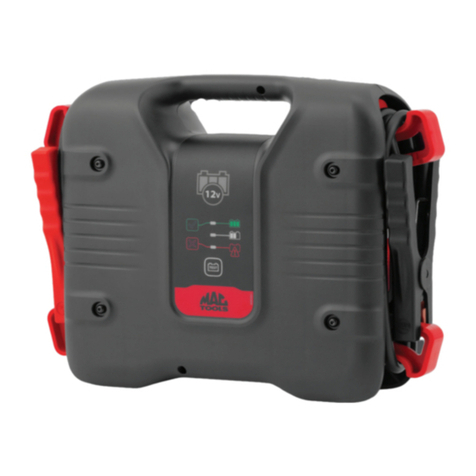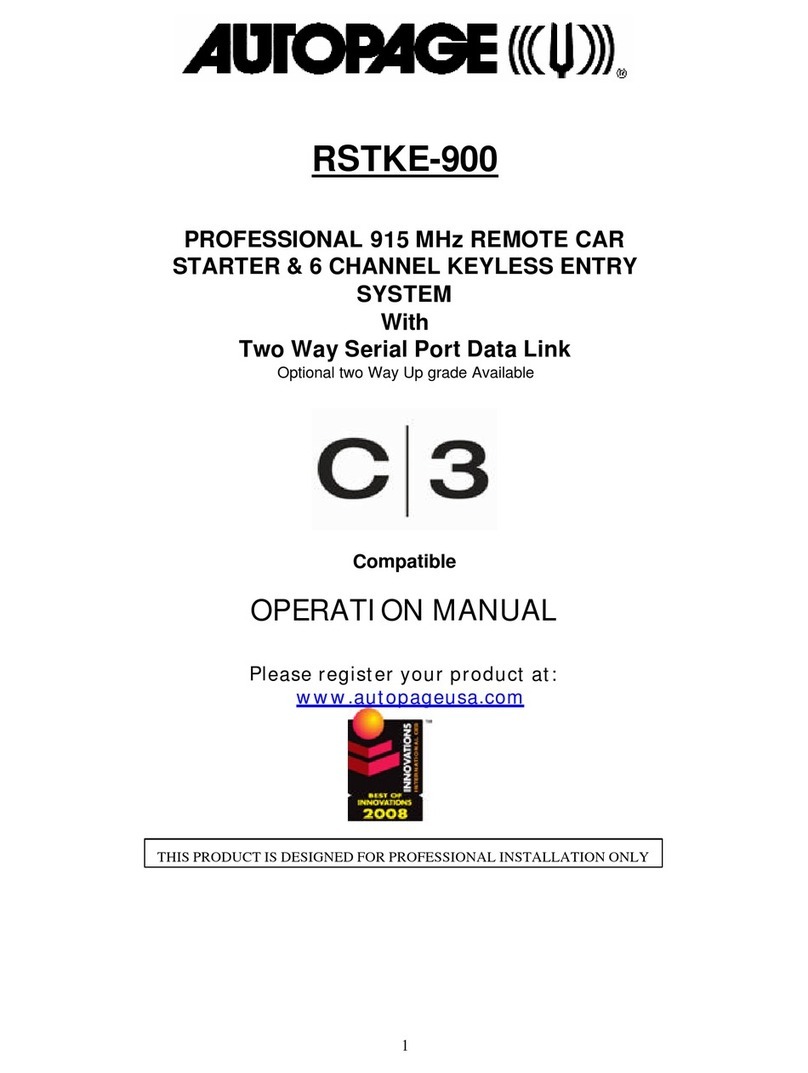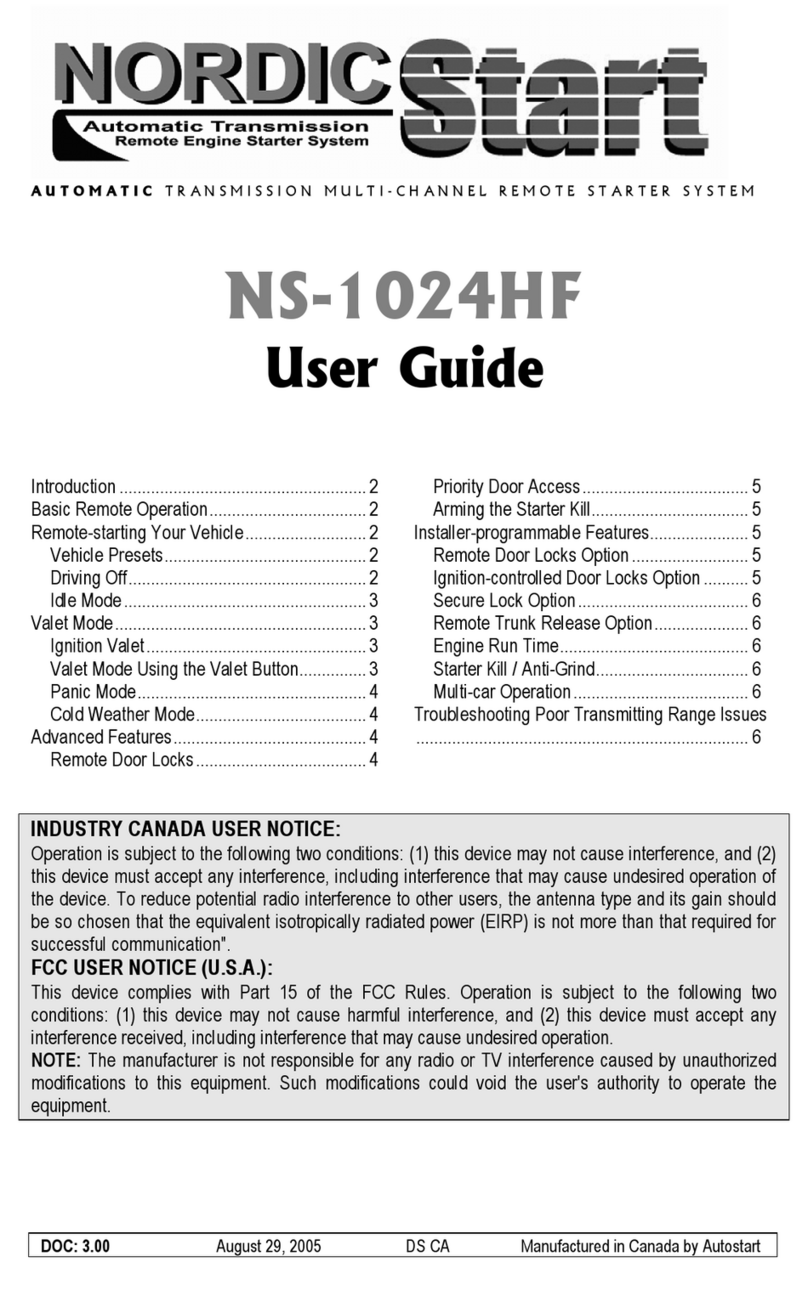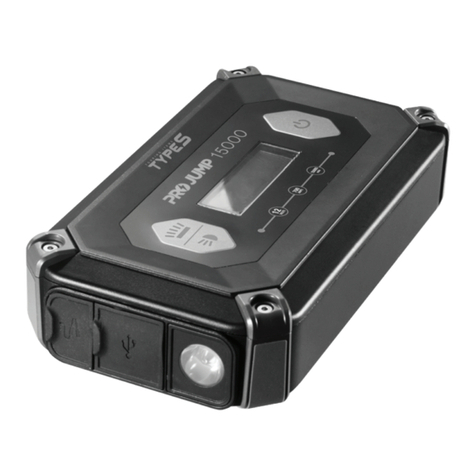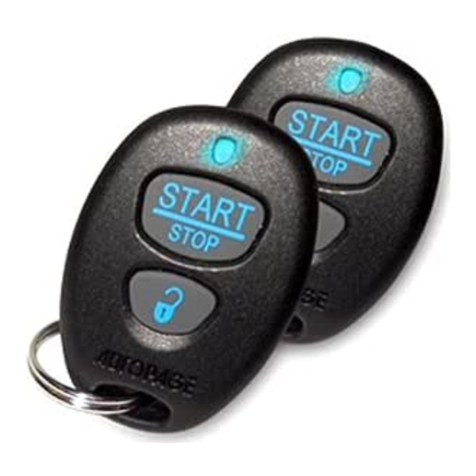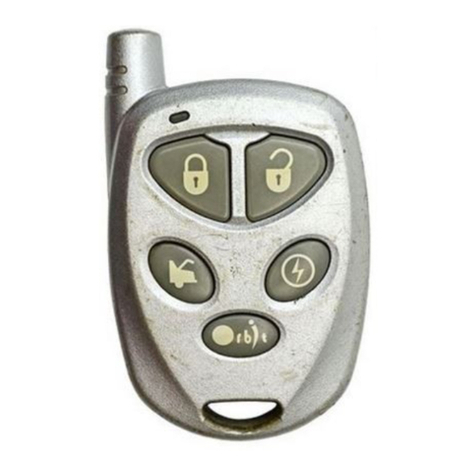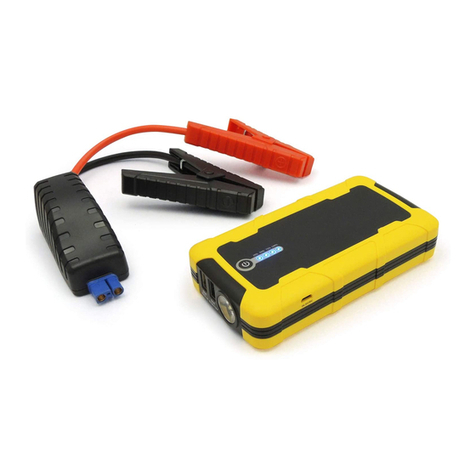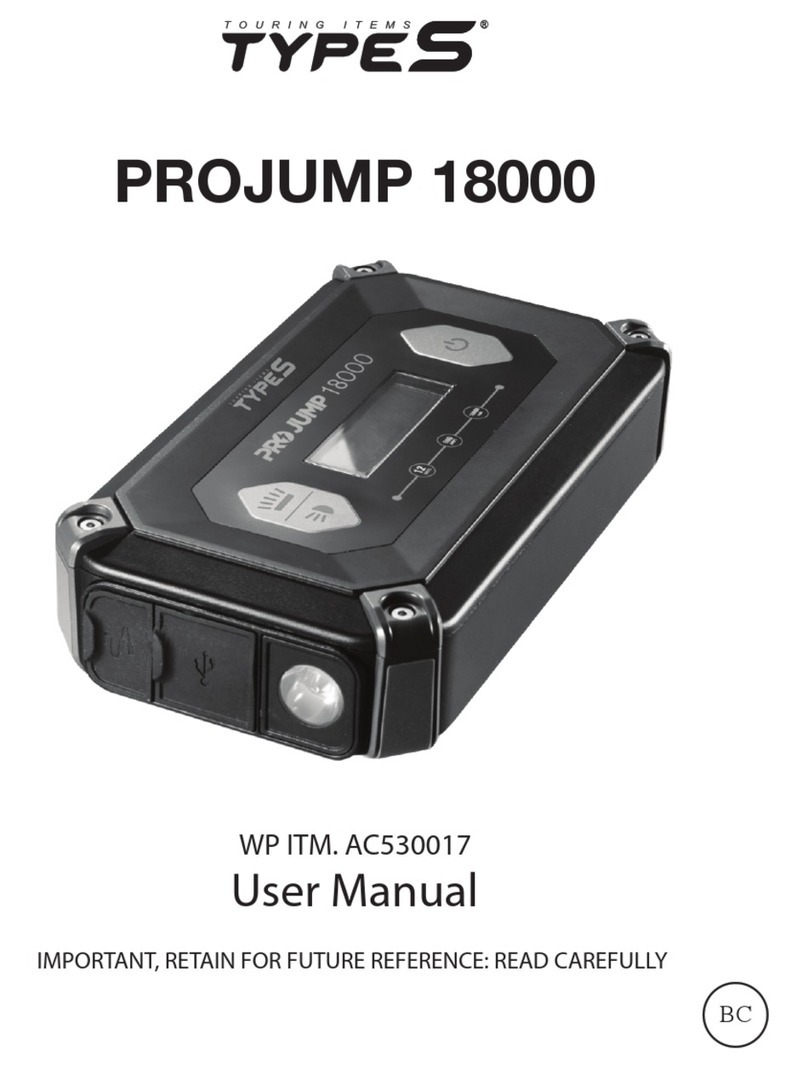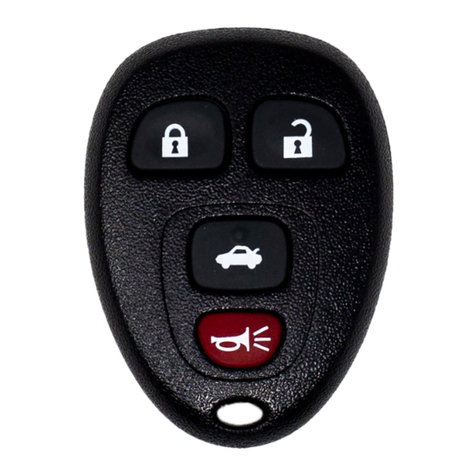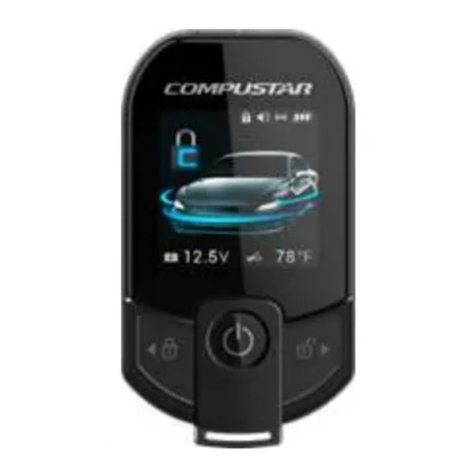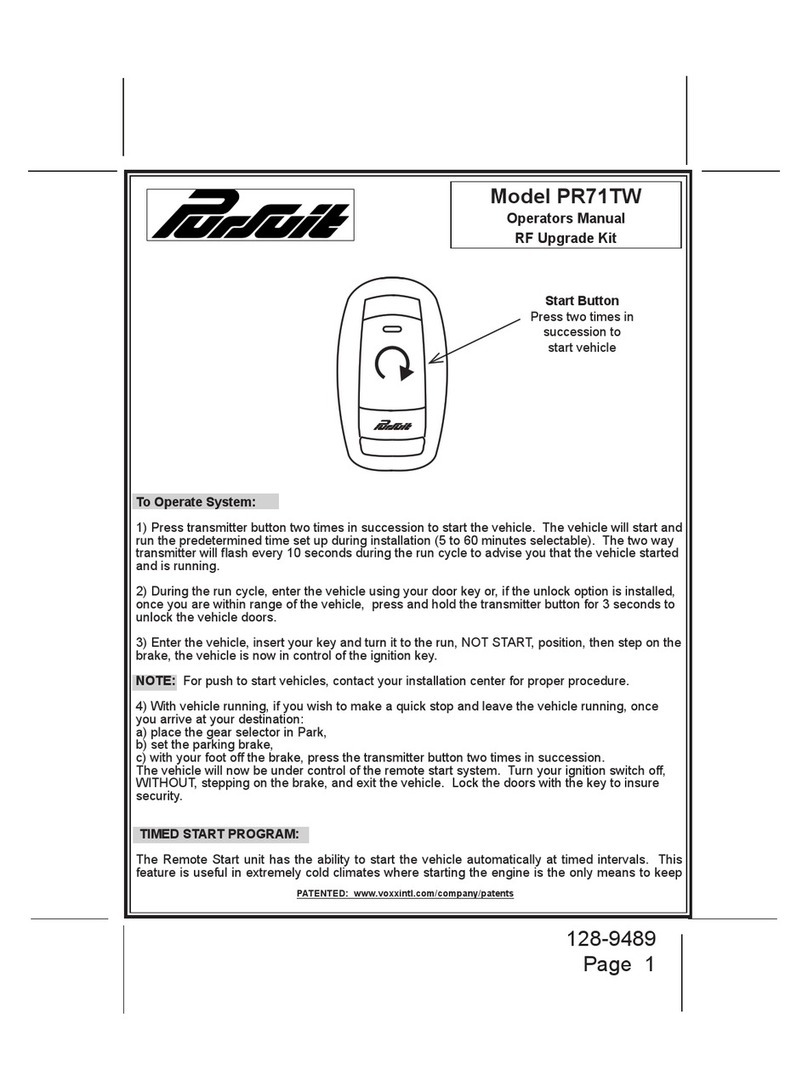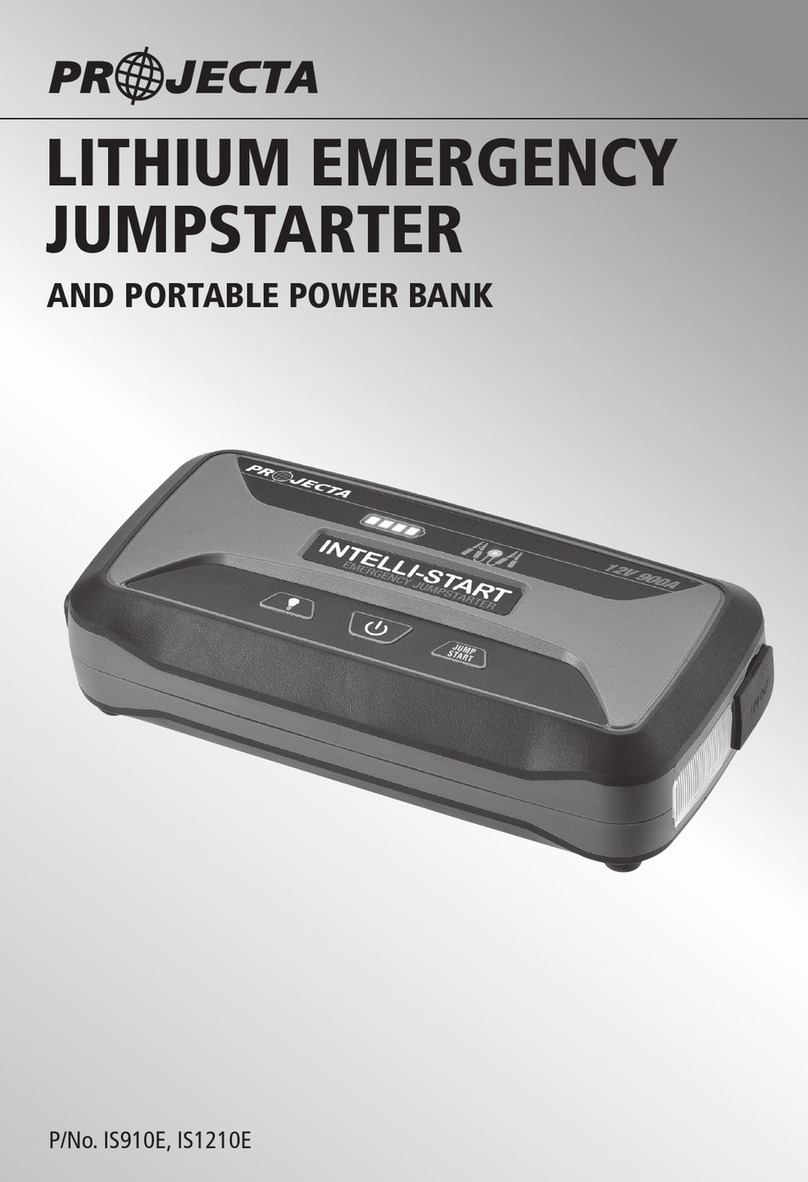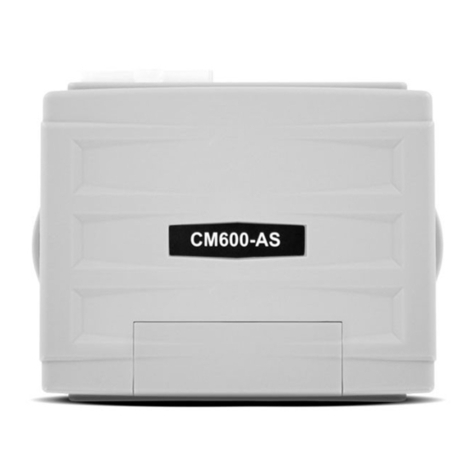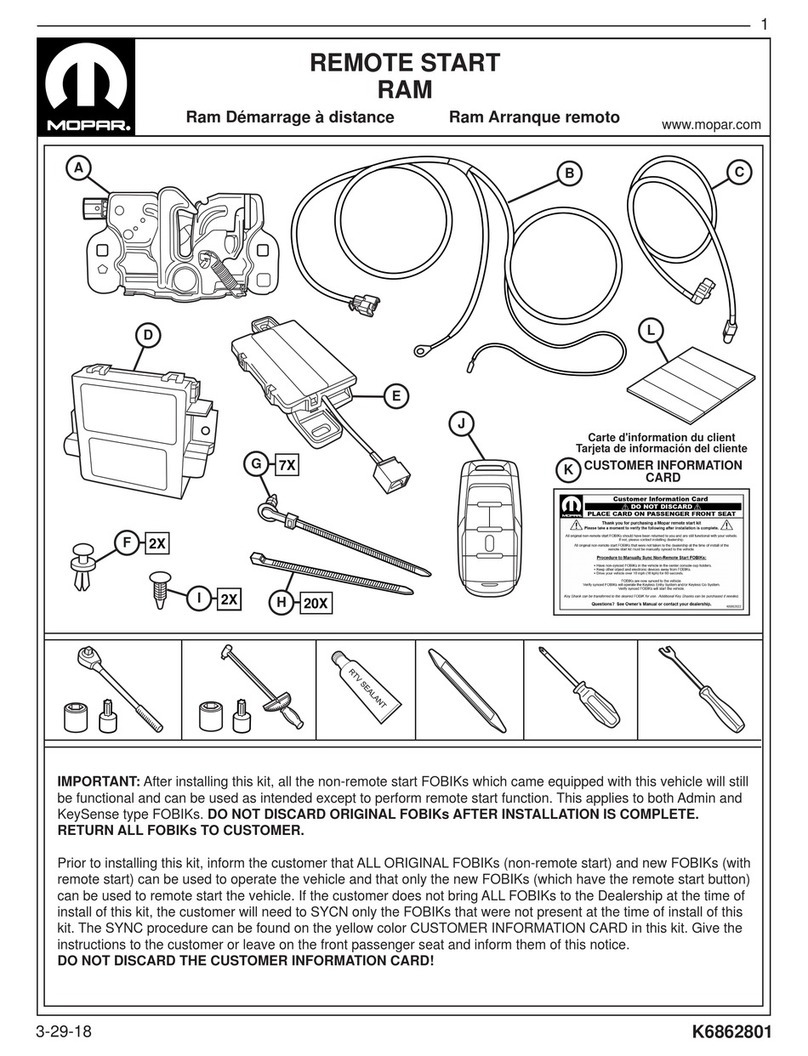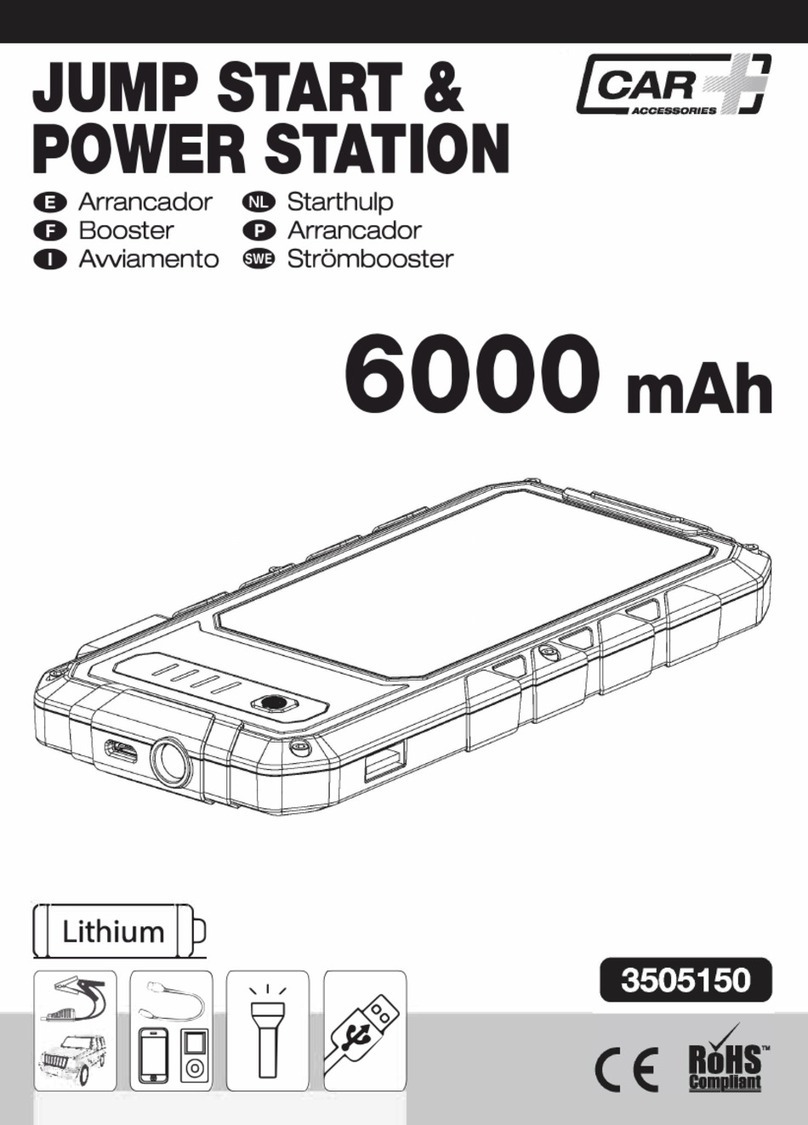MAC TOOLS MTPROA User manual

®
MTPROA, MTPROAGR, MTPROAOR
12V Jump Starter and DC Power Source
© 2020 Mac Tools
To reduce the risk of injury, read and
understand these safety warnings and
instructions before using the tool.
Keep these instructions with the tool
for future reference. If you have any
questions, contact your MAC TOOLS
representative or distributor.
WARNING
MTPROA
MTPROAGR
MTPROAOR
Operation and
Maintenance Manual

MACTOOLS.COM
2
INTRODUCTION
The
Mac Tools™MTPROA, MTPROAGR
and
MTPROAOR
are precision-built jump starters, designed for professionals. These jump
starters will deliver efficient, dependable service when used correctly and with care. As with any professional jump starter, for best
performance the manufacturer’s instructions must be followed. Please study this manual before operating the device and understand
the safety warnings and instructions. The instructions on installation, operation and maintenance should be read carefully, and the
manual kept for reference. NOTE: Additional safety measures may be required because of your particular application of the device.
Contact your
Mac Tools
representative or distributor with any questions concerning the device and its use.
MACTOOLS.COM
Mac Tools
•
505 North Cleveland Avenue
•
Westerville, Ohio 43082 800.MACTOOLS
TABLE OF CONTENTS
Introduction 2
Important Safety Instructions 3
Personal Precautions 3
Specifications 4
Preparing to Use the Jump Starter 5
Jump Starter Location 5
Charging the Internal Battery 5
Operating Instructions 6
Fuse Replacement 7
Maintenance Instructions 7
Moving and Storage Instructions 7
Troubleshooting 8
Accessory/Replacement Parts 8
FCC/IC Statements 9
Customer service 9
Warranty 9
WARNING
IMPORTANT SAFETY INFORMATION ENCLOSED.
READ THIS MANUAL BEFORE OPERATING THE MACHINE.
SAVE FOR FUTURE REFERENCE
FAILURE TO OBSERVE THE FOLLOWING WARNINGS COULD RESULT IN INJURY.
Always wear eye protection.
Always wear protective gloves.
CONTAINS SEALED NON-SPILLABLE LEAD-ACID
BATTERY. MUST BE DISPOSED OF PROPERLY.
WARNING: Possible explosion hazard. Contact
with battery acid may cause severe burns and
blindness. Keep out of reach of children.

800.MACTOOLS
3
IMPORTANT SAFETY INSTRUCTIONS
SAVE THESE INSTRUCTIONS.
WARNING
•RISK OF ELECTRIC SHOCK OR FIRE.
• Read the entire manual before using this product. Failure to do so could result in serious injury or death.
• This product is intended for 12V electrical systems. Connecting to a system with higher or lower voltage could cause injury to
the user and damage to the product/systems.
• This jump starter is not intended for use by persons (including children) with reduced physical, sensory or mental capabilities,
or lack of experience and knowledge, unless they have been given supervision or instruction concerning the use of the jump
starter by a person responsible for their safety.
• Children should be supervised, to ensure they do not play with the jump starter.
• Do not put fingers or hands into the jump starter clamps.
• Do not expose the jump starter to rain or snow.
• Do not operate the jump starter with damaged cables or clamps; have the cable or clamp replaced immediately by a qualified service
person.
• Do not operate the jump starter if it has received a sharp blow, been dropped or otherwise damaged in any way; take it to a
qualified service person.
• Do not disassemble the jump starter; take it to a qualified service person when service or repair is required. Incorrect
reassembly may result in a risk of fire or electric shock.
•RISK OF EXPLOSIVE GASES. WORKING IN THE VICINITY OF A LEAD-ACID BATTERY IS
DANGEROUS. BATTERIES GENERATE EXPLOSIVE GASES DURING NORMAL BATTERY
OPERATION. FOR THIS REASON, IT IS OF UTMOST IMPORTANCE THAT YOU FOLLOW THE
INSTRUCTIONS EACH TIME YOU USE THE JUMP STARTER.
•
To reduce the risk of a battery explosion, follow these instructions and those published by the battery manufacturer and the manufacturer
of any equipment you intend to use in the vicinity of the battery. Review the cautionary markings on these products and on the engine.
• This jump starter employs parts, such as circuit breakers, that tend to produce arcs and sparks. If used in a repair facility,
locate this jump starter 18 inches (46 cm) or more above floor level.
PERSONAL PRECAUTIONS
•A spark near the battery may cause a battery explosion. To reduce the risk of a spark near the battery:
•Work in a well-ventilated area.
•NEVER smoke or allow a spark or flame in the vicinity of a battery or engine.
•Remove personal metal items such as rings, bracelets, necklaces and watches when working with a lead-acid battery.
A lead-acid battery can produce a short-circuit current high enough to weld a ring or the like to metal, causing a severe burn.
•Be extra cautious, to reduce the risk of dropping a metal tool onto the battery. It might spark or short-circuit the battery or
other electrical part that may cause an explosion.
•Never jump start a frozen battery.
•To prevent sparking, NEVER allow clamps to touch together or contact the same piece of metal.
WARNING! RISK OF CONTACT WITH BATTERY ACID. BATTERY ACID IS A HIGHLY
CORROSIVE SULFURIC ACID.
•Consider having someone nearby to come to your aid when you work near a lead-acid battery.
•Have plenty of fresh water and soap nearby in case battery acid contacts your skin, clothing or eyes.
•Wear complete eye and body protection, including safety goggles, gloves and protective clothing. Avoid touching your eyes
while working near the battery.
•If battery acid contacts your skin or clothing, immediately wash the area with soap and water. If acid enters your eye,
immediately flood the eye with cold running water for at least 10 minutes and get medical attention right away.
•If battery acid is accidentally swallowed, contact poison control and reference MSDS. Seek medical attention immediately.
•Keep the jump starter in the specified temperature range: operation: -10°C (14°F) to 40°C (104°F); charging: 0°C (32°F) to
40°C (104°F); storage : -15°C (5°F) to 40°C (104°F).

MACTOOLS.COM
4
SPECIFICATIONS
SPECIFICATIONS
Model # Internal
Battery Type Capacity Nominal
Voltage
12V Aux. DC
Power Output
Rated
Cranking Amps Fuse
MTPROA
MTPROAGR
MTPROAOR
Sealed,
maintenance-free AGM
lead-acid 20Ah (C20) 12V DC 15A 400 300A
Model # Charger
Input
Charger
Output
Operating
Temperature
Charging
Temperature
Storage
Temperature
Weight
lbs / kg
Dimensions
in / mm
MTPROA
MTPROAGR
MTPROAOR
100-240V,
50/60 Hz,
0.7 A max. 12V 2 A -10°C (14°F)
to 40°C (104°F)
0°C (32°F)
to 40°C (104°F)
-15°C (5°F)
to 40°C (104°F) 23 / 11 16 x 4.72 x 12.6
405 x 120 x 320
Battery status button
Fuse
Cord/clamp holder
Charging/battery status LEDs
AC charging socket
12V DC power outlet
Heavy-duty battery clamps

800.MACTOOLS
5
PREPARING TO USE THE JUMP STARTER
WARNING! RISK OF CONTACT WITH BATTERY ACID. BATTERY ACID IS A HIGHLY
CORROSIVE SULFURIC ACID.
•Remove all cord wraps and uncoil the cables prior to using the jump starter.
•Be sure the area around the battery is well ventilated while the jump starter is being used.
•Clean the battery terminals before using the jump starter. During cleaning, keep airborne corrosion from coming into contact
with your eyes, nose and mouth. Use baking soda and water to neutralize the battery acid and help minimize airborne
corrosion. Do not touch your eyes, nose or mouth.
•Determine the voltage of the battery by referring to the vehicle owner’s manual and make sure that the output voltage of the
jump starter is correct.
•Make sure that the jump starter cable clamps make tight connections.
JUMP STARTER LOCATION
WARNING! RISK OF EXPLOSION AND CONTACT WITH BATTERY ACID.
•Locate the jump starter as far away from the battery as the DC cables permit.
•Never place the jump starter directly above the battery being jumped; gases from the battery will corrode and damage the
jump starter.
•Do not operate the jump starter in a closed-in area or restrict the ventilation in any way.
CHARGING THE INTERNAL BATTERY OF THE JUMP STARTER
IMPORTANT: CHARGE IMMEDIATELY AFTER PURCHASE, AFTER EACH USE AND EVERY 30 DAYS TO KEEP THE JUMP STARTER’S
INTERNAL BATTERY FULLY CHARGED. CHARGE THE JUMP STARTER INDOORS ONLY.
•Use only the included power cord.
•To reduce the risk of electric shock, unplug the jump starter before attempting any maintenance or cleaning.
•When charging the internal battery, work in a well-ventilated area and do not restrict the ventilation in any way.
LED INDICATORS
•Internal Battery Status
Make sure the jump starter is not connected to a power source or a vehicle battery.
Press the Battery Status button on the front of the jump starter.
•Red – Charge now
•Yellow – Charge soon
•Green – Ready for jump start
•Charging Status
Connect the jump starter to a live power source.
•Blinking Yellow – Battery is charging
•Solid Green – Battery is fully charged
•Charging Percentage
While the unit is charging, press the Battery Status button .
The LEDs indicate the charging percentage.
•Red – 1-49% charge
•Yellow – 50-89% charge
•Green – 90% or higher charge
•Combined Internal Battery and Vehicle Battery Charge
Connect the jump starter to a vehicle battery and press the Battery Status button .
The LEDs will show the combined internal battery and vehicle battery charge.
NOTE: this is not a true reading.
•Red – Charge now
•Yellow – Charge soon
•Green – Fully charged

MACTOOLS.COM
6
•Charging The Internal Battery, Using the Built-In Charger
Charge the internal battery for the jump starter using the included power cord.
WARNING! USE OF AN IMPROPER POWER CORD MAY RESULT IN A RISK OF FIRE
AND ELECTRIC SHOCK.
1. Connect the power cord to the AC charging socket on the side of the jump starter.
2. Plug the power cord into a 120VAC electrical wall outlet.
3. While the jump starter is charging, the yellow LED will blink.
4. Complete charging may take up to 12 hours. When the yellow LED turns off and the green LED lights, the jump starter
is ready to use.
5. When the internal battery is fully charged, the charger will automatically go into maintain mode and maintain the battery
at full charge.
6. Charge the jump starter as soon as possible after use.
OPERATING INSTRUCTIONS
•Jump Starting a Vehicle Engine
IMPORTANT: Using the jump starter without a battery installed in the vehicle may damage the vehicle’s electrical system.
IMPORTANT: Do not use the jump starter while charging the internal battery.
WARNING! A SPARK NEAR THE BATTERY MAY CAUSE A BATTERY EXPLOSION.
TO REDUCE THE RISK OF A SPARK NEAR THE BATTERY:
1. Turn the vehicle’s ignition OFF before making cable connections.
2. Position the jump cables to reduce the risk of damage by the hood, door and moving of hot engine parts.
3. Stay clear of fan blades, belts, pulleys and other parts that can cause injury. NOTE: If it is necessary to close the hood during
the jump starting process, ensure that the hood does not touch the battery clamps or cut the insulation of the cables.
4. Check the polarity of the battery posts.
5. Determine which post of the battery is grounded (connected) to the chassis. If the negative post is grounded to the
chassis (as in most vehicles), see step 6. If the positive post is grounded to the chassis, see step 7.
6. For a negative-grounded vehicle, connect the POSITIVE (RED) clamp from the jump starter to the POSITIVE (POS, P, +)
ungrounded post of the battery. Connect the NEGATIVE (BLACK) clamp to the vehicle chassis or engine block away from the
battery. Do not connect the clamp to the carburetor, fuel lines or sheet-metal body parts. Connect to a heavy gauge metal
part of the frame or engine block.
7. For a positive-grounded vehicle, connect the NEGATIVE (BLACK) clamp from the jump starter to the NEGATIVE (NEG, N, -)
ungrounded post of the battery. Connect the POSITIVE (RED) clamp to the vehicle chassis or engine block away from the
battery. Do not connect the clamp to the carburetor, fuel lines or sheet-metal body parts. Connect to a heavy gauge metal
part of the frame or engine block.
8. Crank the engine. If the engine does not start within 10 seconds, stop cranking and wait at least 1 minute before
attempting to start the vehicle again. (This permits the jump starter battery to cool down.)
9. After the engine starts, disconnect the black clamp (-) and then the red clamp, (+) in that order (for a negative-grounded vehicle).
10. Recharge the jump starter as soon as possible after use.
•Powering a 12V DC device
The jump starter is a power source for all 12V DC accessories that are equipped with a 12V accessory plug.
CAUTION: Do not use the jump starter to run appliances that draw more than 15A DC.
NOTE: Extended operation of a 12V DC device may result in excessive battery drain. Recharge the jump starter immediately
after unplugging the 12V DC device.
NOTE: Do not power a 12V device with the jump starter while charging the internal battery.
1. Make sure the device to be powered is OFF before inserting the 12V DC accessory plug into the 12V DC accessory outlet.
2. Open the protective cover of the DC power outlet on the jump starter.
3. Plug the 12V DC device into the DC power outlet and turn on the 12V DC device (if required).
4. When finished, turn off the DC device (if required) and unplug from the DC power outlet.

800.MACTOOLS
7
FUSE REPLACEMENT
The jump starter is equipped with a replaceable fuse, to protect the battery from overload.
•Fuse Specification
Littelfuse BF2 series type, rated 32 V, 300 A.
WARNING! KEEP AWAY FROM SPARKS AND FLAME – BATTERY COULD EMIT EXPLOSIVE GASES.
1. Allow the fuse to cool down completely (approximately 5 minutes).
2. Make sure the the unit is unplugged from any power source.
3. Remove the negative (BLACK) clamp and cable from the cord/clamp holder on the side of the unit and locate the fuse cover.
4. Follow the arrow to open the right side of the fuse cover, and then rotate the cover from right to left to remove it.
5. Using a 13mm socket/wrench, remove both nuts and washers.
6. Remove the open fuse and replace it with a new one of the same type and rating.
7. Replace and torque the top nut/washer to 50 in-lbs. to secure the fuse.
8. Replace the fuse cover.
9. The unit is now ready to use.
MAINTENANCE INSTRUCTIONS
•After use and before performing maintenance, unplug and disconnect the jump starter.
•Use a dry cloth to wipe all battery corrosion and other dirt or oil from the battery clamps, cords, and the jump starter’s case.
•Ensure that all of the jump starter’s components are in place and in good working condition.
•Servicing does not require opening the unit, as there are no user-serviceable parts (except the fuse). All servicing should be
performed by qualified service personnel.
MOVING AND STORAGE INSTRUCTIONS
WARNING! THE CLAMPS ARE LIVE AND WILL PRODUCE ARCING OR SPARKING IF THEY
COME IN CONTACT WITH EACH OTHER.
•Do not store the clamps clamped together, on or around metal, or clamped to cables. Keep the clamps on the storage holders
when not in use.
• Store the jump starter in an upright position.
•Store inside, in a cool, dry place.
•If the jump starter is moved around the shop or transported to another location, take care to avoid/prevent damage to the cords,
clamps and jump starter. Failure to do so could result in personal injury or property damage.

MACTOOLS.COM
8
TROUBLESHOOTING
PROBLEM POSSIBLE CAUSE SOLUTION
The jump starter won’t jump start my car. Clamps are not making a good
connection to the battery.
Connections are reversed.
The jump starter’s battery is not
charged.
The vehicle’s battery is defective.
The fuse has opened.
Check for poor connection to battery
and frame. Make sure connection points
are clean.
Disconnect the jump starter and reverse
the clamps. The fuse will need to be
replaced.
Press the Battery Status button
on the front of the unit. The LEDs will
indicate the status of charge.
Have the battery checked.
Replace the fuse.
The jump starter won’t power my 12V
device.
The 12V device is not turned on.
The jump starter’s battery is not
charged.
The 12V device draws more than 15A
or has a short circuit.
Turn on the 12V device.
Check the battery charge status by
pressing the Battery Status button.
Disconnect the 12V device. The internal
breaker will automatically reset after a
minute or two. Try the 12V device again.
The battery in the jump starter won’t
hold a charge.
The battery is bad
(will not accept a charge).
Replace the battery.
ACCESSORY/REPLACEMENT PARTS
PART # DESCRIPTION REPAIR LOCATION
MTPROA-F FUSE REPLACEMENT KIT User
MTPROA-FC FUSE COVER REPLACEMENT Repair center
MTPROA-RC RED (POSITIVE) REPLACEMENT CLAMP Repair center
MTPROA-BC BLACK (NEGATIVE) REPLACEMENT CLAMP Repair center
MTPROA-B BATTERY REPLACEMENT KIT Repair center
MTPROA-DC 12V DC PORT REPLACEMENT KIT Repair center
MTPROA-CBS BATTERY CABLE REPLACEMENT KIT Repair center
MTPROA-PC POWER CORD REPLACEMENT User
MTPROA-2MC MALE-TO-MALE VEHICLE CIGARETTE LIGHTER ADAPTER User

800.MACTOOLS
9
FCC STATEMENT
NOTE: This equipment has been tested and found to comply with the limits for a Class B digital device, pursuant to part 15 of
the FCC Rules and Canadian specification ICES-003. These limits are designed to provide reasonable protection against harmful
interference in a residential installation. This equipment generates, uses and can radiate radio frequency energy and, if not
installed and used in accordance with the instructions, may cause harmful interference to radio communications. However, there is
no guarantee that interference will not occur in a particular installation. If this equipment does cause harmful interference to radio
or television reception, which can be determined by turning the equipment off and on, the user is encouraged to try to correct the
interference by one or more of the following measures:
•Reorient or relocate the receiving antenna.
•Increase the separation between the equipment and receiver.
•Connect the equipment into an outlet on a circuit different from that to which the receiver is connected.
•Consult the dealer or an experienced radio/TV technician for help.
IC STATEMENT
This device contains license-exempt transmitter(s)/receiver(s) that comply with Innovation, Science and Economic Development
Canada’s license-exempt RSS(s). Operation is subject to the following two conditions:
1. This device may not cause interference.
2. This device must accept any interference, including interference that may cause undesired operation of the device.
CUSTOMER SERVICE
We at Mac Tools are committed to our customers, please reference the following phone number for a direct contact to one of our customer
technicians. They will be more than happy to help with any service or warranty questions you may have about your jump starter.
MACTOOLS.COM
Mac Tools
•
505 North Cleveland Avenue
•
Westerville, Ohio 43082 800.MACTOOLS
WARRANTY
We warrant that this jump starter shall be free from manufacturing defects for a period of ONE YEAR from the original purchase date.
Our obligation to the original purchaser shall be limited to repairing or replacing, at our expense (not including shipping charges)
a defective device if returned by the original purchaser within one year from the date of purchase, all incoming shipping charges
prepaid. THIS LIMITED WARRANTY DOES NOT COVER DEFECTS OR DAMAGES TO THE DEVICE (i) after the warranty period expires; (ii)
resulting from misuse or abnormal operation; (iii) resulting from a failure to properly maintain or operate the device or (iv) resulting
from any repair or maintenance services performed by any party other than Mac Tools.

®
10
NOTES
Manual #0099002278-00

®
MTPROA, MTPROAGR, MTPROAOR
Arrancador auxiliar de 12 V y fuente de alimentación de CC
© 2020 Mac Tools
Para reducir el riesgo de lesiones,
lea y comprenda estas advertencias e
instrucciones de seguridad antes de usar la
herramienta. Conserve estas instrucciones
junto con la herramienta para consulta
en el futuro. Si tiene alguna pregunta,
póngase en contacto con su representante
o distribuidor de MACTOOLS.
ADVERTENCIA
MTPROA
MTPROAGR
MTPROAOR
Manual de operación
y mantenimiento

MACTOOLS.COM
12
INTRODUCCIÓN
Los
Mac Tools™MTPROA, MTPROAGR
y
MTPROAOR
son arrancadores auxiliares de precisión, diseñados para profesionales. Los
arrancadores ofrecen un servicio confiable y eficiente cuando se utilizan de la manera correcta y con cuidado. Al igual que con cualquier
otro arrancador profesional, deben seguirse las instrucciones del fabricante para un mejor funcionamiento. Estudie este manual antes de
utilizar el equipo y verifique que comprende las advertencias y las instrucciones de seguridad. Las instrucciones de instalación, operación
y mantenimiento deben leerse con atención y debe conservarse el manual para tener como referencia. NOTA: Es posible que sea necesario
implementar medidas adicionales de seguridad debido a la aplicación específica en la que emplee el equipo.
Póngase en contacto con su representante o distribuidor de
Mac Tools
si tiene alguna pregunta con respecto al equipo y su uso.
MACTOOLS.COM
Mac Tools
•
505 North Cleveland Avenue
•
Westerville, Ohio 43082 800.MACTOOLS
TABLA DE CONTENIDOS
Introducción 12
Instrucciones de seguridad importantes 13
Precauciones personales 13
Especificaciones 14
Preparación para el uso del arrancador 15
Ubicación del arrancador 15
Carga de la batería interna del arrancador 15
Instrucciones de funcionamiento 16
Cambio de los fusibles 17
Instrucciones de mantenimiento 17
Instrucciones de transporte y almacenamiento 17
Resolución de problemas 18
Accesorios/Repuestos 18
Declaraciones de la FCC / IC 19
Servicio al cliente 19
Garantía 19
ADVERTENCIA
SE INCLUYE INFORMACIÓN DE SEGURIDAD IMPORTANTE.
LEA ESTE MANUAL ANTES DE UTILIZAR LA MÁQUINA.
CONSERVE PARA REFERENCIA FUTURA
LA NO OBSERVACIÓN DE LAS ADVERTENCIAS PUEDE OCASIONAR DAÑO.
Siempre use protección para los ojos.
Siempre use guantes.
CONTIENE BATERÍA DE PLOMO ÁCIDO SELLADA
A PRUEBA DE DERRAMES. SE LA DEBE
DESECHAR DE LA MANERA APROPIADA.
ADVERTENCIA: Posible riesgo de explosión.
El contacto con la batería de ácido puede
causar quemaduras severas y ceguera.
Mantenga fuera del alcance de los niños.

800.MACTOOLS
13
INSTRUCCIONES DE SEGURIDAD IMPORTANTES
CONSERVE ESTAS INSTRUCCIONES.
ADVERTENCIA
•RIESGO DE DESCARGA ELÉCTRICA O INCENDIO.
• Lea el manual completo antes de utilizar este producto. En caso contrario, puede producirse alguna lesión grave o la muerte.
• Este producto está diseñado para sistemas eléctricos de 12V. La conexión a un sistema de mayor o menor tensión puede
causar lesiones al usuario y daño al producto/sistemas.
• Este arrancador no está destinado para el uso por parte de personas (incluidos niños) con capacidades físicas, sensoriales o
mentales reducidas, o que carezcan de experiencia o de conocimientos necesarios, a menos que estén supervisadas o reciban
las instrucciones relativas al uso del mismo de parte de una persona encargada de su seguridad.
• Los niños deben permanecer vigilados para garantizar que NO jueguen con el arrancador.
• No coloque los dedos ni las manos en las pinzas del arrancador.
• No exponga el arrancador a la lluvia ni la nieve.
• No utilice el arrancador con cables o pinzas dañados. Es necesario reemplazar de inmediato el cable o la pinza mediante un
técnico calificado.
• No utilice el arrancador si ha recibido un golpe fuerte, si se cayó o si está dañado de algún modo. Llévelo a un técnico calificado.
• No desarme el arrancador; llévelo a un técnico calificado cuando necesite mantenimiento o una reparación. El montaje
incorrecto puede traer aparejado riesgo de incendio o descarga eléctrica.
•RIESGO DE GASES EXPLOSIVOS. EL TRABAJO EN LA CERCANÍA DE UNA BATERÍA DE
PLOMO ÁCIDO ES PELIGROSO. LAS BATERÍAS GENERAN GASES EXPLOSIVOS DURANTE
EL FUNCIONAMIENTO NORMAL. POR ESTA RAZÓN, ES FUNDAMENTAL QUE SIGA LAS
INSTRUCCIONES TODAS LAS VECES QUE UTILICE EL ARRANCADOR.
• A fin de reducir el riesgo de explosión de una batería, siga estas instrucciones y las del fabricante de la batería, así como las del
fabricante del equipo que pretende utilizar cerca de la batería. Revise las marcas de precaución de estos productos y del motor.
• El arrancador utiliza piezas, tales como interruptores, que tienden a producir arco y chispas. En caso de utilizar en un taller de
reparaciones, coloque el arrancador a 18 pulgadas (46 cm) o más por encima del nivel del piso.
PRECAUCIONES PERSONALES
•Una chispa cerca de una batería puede causar una explosión. A fin de reducir el riesgo de chispa cerca de la batería:
•Trabaje en un área bien ventilada.
•NUNCA fume ni permita que haya chispas o llama cerca de una batería o motor.
•Retire los elementos metálicos personales tales como anillos, pulseras, collares y relojes al trabajar con baterías de plomo-
ácido. Una batería de plomo-ácido puede producir una corriente de cortocircuito tal que haga soldar un anillo o similar al
metal, causando una quemadura severa.
•Tenga extremo cuidado a fin de reducir el riesgo de dejar caer una herramienta metálica en la batería. Puede causar chispa o
un cortocircuito en la batería u otra pieza eléctrica, lo que puede causar una explosión.
•Nunca use el arrancador con una batería congelada.
•A fin de prevenir la formación de chispa, NUNCA permita que las pinzas hagan contacto entre sí ni con la misma pieza metálica.
¡ADVERTENCIA! RIESGO DE CONTACTO CON EL ÁCIDO DE LA BATERÍA. EL ÁCIDO DE
LA BATERÍA ES SULFÚRICO, ALTAMENTE CORROSIVO.
•Considere que haya otra persona a mano para ayudarlo cuando trabaje cerca una batería de plomo-ácido.
•Tenga suficiente agua potable y jabón cerca en caso de contacto del ácido de la batería con la piel, la ropa o los ojos.
•Use protección completa para los ojos y el cuerpo, incluidas antiparras, guantes y ropa de protección. Evite tocarse los ojos
mientras trabaje cerca de la batería.
•En caso de contacto del ácido de la batería con la piel o la ropa, lave el área de inmediato con agua y jabón. En caso de ingreso de
ácido al ojo, enjuáguelo de inmediato con agua corriente fría al menos durante 10 minutos y consiga atención médica de inmediato.
•En caso de ingesta accidental de ácido de la batería, póngase en contacto con control de envenenamiento y haga referencia a
las hojas de datos de seguridad de materiales (MSDS). Consiga atención médica inmediata.
•Mantenga al arrancador dentro del rango de temperatura especificado: en funcionamiento: -10 °C (14 °F) a 40 °C (104 °F);
en carga: 0 °C (32 °F) a 40 °C (104 °F); en depósito: -15 °C (5 °F) a 40 °C (104 °F).

MACTOOLS.COM
14
ESPECIFICACIONES
Número de
modelo Tipo de batería interna Capacidad Tensión
nominal
Alimentación
auxiliar
de 12 V CC
Amperios
clasificados
de arranque
Fusible
MTPROA
MTPROAGR
MTPROAOR
De plomo-ácido, de fibra de
vidrio absorbente sellada,
libre de mantenimiento 20 Ah (C20) 12 V CC 15 A 400 300 A
Número de
modelo
Entrada del
cargador
Salida del
cargador
Temperatura de
funcionamiento
Temperatura
de carga
Temperatura de
almacenamiento
Peso
lb/kg
Dimensiones:
pulg./mm
MTPROA
MTPROAGR
MTPROAOR
100-240 V,
50/60Hz,
0,7A máx. 12 V 2 A -10 °C (14 °F) a
40 °C (104 °F)
0 °C (32 °F) a 40
°C (104 °F)
-15 °C (5 °F) a
40 °C (104 °F) 23/11 16 x 4,72 x 12,6
405 x 120 x 320
ESPECIFICACIONES
Botón de estado de la batería
Fusible
Soporte de cable/pinza
LED de estado de carga/batería
Toma de carga de CA
Toma de alimentación
de 12 V CC
Pinzas de batería
de servicio pesado

800.MACTOOLS
15
PREPARACIÓN PARA EL USO DEL ARRANCADOR
¡ADVERTENCIA! RIESGO DE CONTACTO CON EL ÁCIDO DE LA BATERÍA. EL ÁCIDO DE
LA BATERÍA ES SULFÚRICO, ALTAMENTE CORROSIVO.
•Retire el envoltorio de los cables y desenrósquelos previo al uso del arrancador.
•Verifique la buena ventilación de la zona donde se encuentra la batería mientras se utilice el arrancador.
•Limpie los bornes de la batería antes de utilizar el arrancador. Durante la limpieza, evite el contacto del material corrosivo
a través del aire con los ojos, nariz y boca. Utilice bicarbonato de sodio y agua para neutralizar el ácido de la batería y
minimizar la corrosión dispersa en el aire. No se toque los ojos, la nariz ni la boca.
•Determine la tensión de la batería en el manual del dueño del vehículo, y que la tensión de salida del arrancador es la correcta.
•Verifique la buena conexión de las pinzas del cable del arrancador.
UBICACIÓN DEL ARRANCADOR
¡ADVERTENCIA! RIESGO DE EXPLOSIÓN Y CONTACTO CON EL ÁCIDO DE LA BATERÍA.
•Coloque el arrancador lo más lejos posible de la batería que permitan los cables de CC.
•Nunca coloque el arrancador directamente sobre la batería a conectar en puente dado que los gases de esta corroen y dañan
el arrancador.
•No utilice el arrancador en un área cerrada ni restrinja la ventilación de modo alguno.
CARGA DE LA BATERÍA INTERNA DEL ARRANCADOR
IMPORTANTE: CARGUE DE INMEDIATO DESPUÉS DE LA COMPRA, DE CADA USO Y CADA 30 DÍAS A FIN DE MANTENER LA BATERÍA
INTERNA DEL ARRANCADOR CON CARGA PLENA. SOLO CARGUE EL ARRANCADOR EN INTERIORES.
• Solo utilice el cable suministrado.
• A fin de reducir el riesgo de descarga eléctrica, desenchufe el arrancador antes de realizar mantenimiento o limpieza.
• Cuando cargue la batería interna, trabaje en una zona bien ventilada no restrinja la ventilación de modo alguno.
INDICADORES LED
•Estado de la batería interna
Verifique que el arrancador no esté conectado a la alimentación ni a la batería de ningún vehículo.
Pulse el botón de Estado de la Batería en el frente del arrancador.
•Rojo – cargue ahora
•Amarillo - cargue pronto
•Verde - lista para dar arranque
•Estado de carga
Conecte el arrancador a una fuente viva.
•Amarillo parpadeante - batería cargándose
•Verde constante - batería con carga plena
•Porcentaje de carga
Mientras se carga el equipo, pulse el botón de Estado de la Batería .
Los LED indican el porcentaje de carga.
•Rojo – 1-49% de carga
•Amarillo – 50-89% de carga
•Verde – 90% de carga o más
•Carga combinada de batería interna y del vehículo
Conecte el arrancador a la batería del vehículo y pulse el botón Estado de la Batería .
Los LED indican la carga combinada de batería interna y del vehículo.
NOTA: Esta no es una lectura real.
•Rojo – cargue ahora
•Amarillo - cargue pronto
•Verde – carga completa

MACTOOLS.COM
16
•Carga de la batería interna con el cargador incorporado
Cargue la batería interna del arrancador con el cable incluido.
¡ADVERTENCIA! EL USO DE UN CABLE DE ALIMENTACIÓN INADECUADO PUEDE TRAER
APAREJADO RIESGO DE INCENDIO O DESCARGA ELÉCTRICA.
1. Conecte el cable al toma de carga de CA del lateral del arrancador.
2. Enchufe el cable de alimentación en un toma de red de 120 V CA.
3. Mientras el arrancador está cargando titila el LED amarillo.
4. La carga completa puede llevar hasta 12 horas. Cuando se apaga el LED amarillo y se enciende el verde, el arrancador
está listo para el uso.
5. Cuando la batería interna tiene carga completa, el arrancador automáticamente entra al modo mantenimiento y
mantiene a la batería a carga plena.
6. Cargue el arrancador lo antes posible después del uso.
INSTRUCCIONES DE FUNCIONAMIENTO
•Arranque del motor de un vehículo
IMPORTANTE: El uso del arrancador sin batería instalada en el vehículo puede dañar el sistema eléctrico de este.
IMPORTANTE: No utilice el arrancador cuando está cargando la batería interna.
¡ADVERTENCIA! UNA CHISPA CERCA DE UNA BATERÍA PUEDE CAUSAR UNA EXPLOSIÓN.
A FIN DE REDUCIR EL RIESGO DE CHISPA CERCA DE LA BATERÍA:
1. Apague el motor del vehículo antes de conectar los cables.
2. Coloque los cables de arranque de manera tal de reducir el riesgo de daño causado por el capó o la puerta y de
movimiento de las piezas del motor a temperatura.
3. Mantenga la distancia de las aspas del ventilador, las correas, las poleas y otras piezas que puedan causar una lesión.
NOTA: De ser necesario cerrar el capó durante el proceso de arranque, verifique que no esté en contacto con las pinzas de la
batería ni corte la aislación del cable.
4. Verifique la polaridad de los bornes de la batería.
5. Determine el borne con puesta a tierra (conectado) en el chasis. Si el borne negativo tiene la puesta a tierra en el chasis
(como la mayoría de los vehículos), vea el paso 6. Si el borne positivo tiene la puesta a tierra en el chasis, vea el paso 7.
6. Para un vehículo con la puesta a tierra en el negativo, conecte la pinza POSITIVA (ROJA) del arrancador al borne sin conexión
a tierra de la batería, el POSITIVO (POS, P, +). Conecte la pinza NEGATIVA (NEGRA) al chasis del vehículo o el bloque del
motor, lejos de la batería. No conecte la pinza al carburador, las cañerías de combustible o las piezas de chapa de la
carrocería. Conecte a una pieza de metal gruesa de la carrocería o el bloque del motor.
7. Para un vehículo con la puesta a tierra en el positivo, conecte la pinza NEGATIVA (NEGRA) del arrancador al borne sin
conexión a tierra de la batería, el NEGATIVO (NEG, N,-). Conecte la pinza POSITIVA (ROJA) al chasis del vehículo o el
bloque del motor, lejos de la batería. No conecte la pinza al carburador, las cañerías de combustible o las piezas de
chapa de la carrocería. Conecte a una pieza de metal gruesa de la carrocería o el bloque del motor.
8. Dé arranque al motor. Si no arranca dentro de los 10 segundos, detenga el arranque y espere al menos 1 minuto antes de
intentar nuevamente. (Esto permite que se enfríe la batería del arrancador).
9. Después de que arranque el motor, desconecte la pinza negra (-) y luego la roja, (+) en ese orden (para un vehículo con conexión a
tierra en el negativo).
10. Vuelva a cargar el arrancador lo antes posible después del uso.
•Alimentación de un equipo de 12 V CC
El arrancador es una fuente para todos los accesorios de 12 V CC equipados con un enchufe de accesorio de 12 V.
PRECAUCIÓN: No utilice el arrancador para equipos con un consumo superior a 15 A CC.
NOTA: El uso prolongado de un equipo de 12 V CC puede resultar en una descarga excesiva de la batería. Vuelva a cargar el
arrancador de inmediato después de desenchufar el equipo de 12 V CC.
NOTA: No utilice el arrancador para la alimentación de un equipo de 12 V cuando está cargando la batería interna.
1. Verifique que el equipo está apagado antes de colocar el enchufe del accesorio de 12 V CC en la toma de accesorio de 12
V CC.
2. Abra la tapa protectora de la toma de alimentación de CC del arrancador.
3. Enchufe el equipo de 12 V CC en la toma de alimentación de CC y encienda el equipo de 12 V CC (de ser necesario).
4. Al finalizar, apague el equipo de CC (de ser necesario) y desenchúfelo de la toma de alimentación de CC.

800.MACTOOLS
17
CAMBIO DE LOS FUSIBLES
El arrancador está equipado con un fusible intercambiable a fin de proteger a la batería de sobrecarga.
•Especificaciones del fusible
Littelfuse del tipo serie BF2, de 32 V, 300 A.
¡ADVERTENCIA! MANTENGA ALEJADO DE CHISPAS Y LLAMA - LA BATERÍA PUEDE EMITIR
GASES EXPLOSIVOS.
1. Deje que el fusible se enfríe totalmente (aproximadamente 5 minutos).
2. Verifique que el equipo está desconectado de la alimentación.
3. Retire la pinza negativa (NEGRA) y el cable del soporte de cable/pinza del lateral del equipo y ubique la tapa del fusible.
4. Siga la flecha para abrir el lateral derecho de la tapa del fusible y luego gire la tapa de derecha a izquierda para retirarla.
5. Utilizando una llave de tubos de 13mm, retire ambas tuercas y arandelas.
6. Retire el fusible quemado y coloque uno nuevo del mismo tipo y especificaciones.
7. Vuelva a colocar la tuerca/arandela superior y ajuste a 50 pulgadas/libra para asegurar el fusible.
8. Vuelva a colocar la tapa del fusible.
9. Ahora el equipo está listo para usar.
INSTRUCCIONES DE MANTENIMIENTO
•Después del uso y antes del mantenimiento, desconecte el arrancador.
•Utilice un trapo seco para eliminar toda la corrosión de la batería y demás suciedad o aceite de la batería, las pinzas, los
cables y la caja del arrancador.
•Verifique que los componentes del arrancador estén en su lugar y funcionen bien.
•El servicio no implica abrir el equipo, dado que no hay piezas que pueda arreglar el usuario (salvo el cambio de fusible). Las
tareas de servicio deben ser realizadas por personal de reparaciones calificado.
INSTRUCCIONES DE TRANSPORTE Y ALMACENAMIENTO
¡ADVERTENCIA! LAS PINZAS TIENEN CORRIENTE Y PRODUCEN ARCO O CHISPAS SI
ENTRAN EN CONTACTO ENTRE SÍ.
•No guarde las pinzas juntas, sobre metal o alrededor del mismo, ni conectadas a cables. Cuando no estén en uso, guarde las
pinzas en los soportes de guarda.
• Guarde el arrancador en posición vertical.
•Guárdelo en interiores, en un lugar fresco y seco.
•En caso de traslado del arrancador en el taller o de transporte a otro lugar, tome precauciones para evitar dañar los cables, las pinzas
y el arrancador mismo. En caso contrario, puede causarse alguna lesión personal o daño al patrimonio.

MACTOOLS.COM
18
RESOLUCIÓN DE PROBLEMAS
PROBLEMA CAUSA POSIBLE SOLUCIÓN
El arrancador no arranca el automóvil. Las pinzas no hacen buen contacto con
la batería.
Las conexiones están invertidas.
La batería del arrancador no está
cargada.
La batería del vehículo es defectuosa.
El fusible está quemado.
Verifique si hay una mala conexión con
la batería y la carrocería. Verifique la
limpieza de los puntos de conexión.
Desconecte el arrancador e invierta la
posición de las pinzas. Es necesario
cambiar el fusible.
Pulse el botón de Estado de la Batería
en el frente del equipo. Los LED
indican el estado de carga.
Haga revisar la batería.
Cambie el fusible.
El arrancador no alimenta al equipo
de 12 V.
El equipo de 12 V no está encendido.
La batería del arrancador no está
cargada.
El equipo de 12 V tiene un consumo
superior a los 15 A o un cortocircuito.
Encienda el equipo de 12 V.
Verifique el estado de carga de la
batería pulsando el botón de Estado de
la Batería.
Desconecte el equipo de 12 V. El interruptor
interno se restaura automáticamente
después de uno o dos minutos. Vuelva a
probar el equipo de 12 V.
La batería del arrancador no mantiene
la carga.
La batería no funciona
(no toma carga).
Cambie la batería.
ACCESORIOS/REPUESTOS
PIEZA NO. DESCRIPCIÓN LUGAR DE REPARACIÓN
MTPROA-F KIT DE FUSIBLE DE REPUESTO Usuario
MTPROA-FC TAPA DE FUSIBLE DE REPUESTO Centro de reparaciones
MTPROA-RC PINZA ROJA (POSITIVA) DE REPUESTO Centro de reparaciones
MTPROA-BC PINZA NEGRA (NEGATIVA) DE REPUESTO Centro de reparaciones
MTPROA-B KIT DE BATERÍA DE REPUESTO Centro de reparaciones
MTPROA-DC KIT DE PUERTO DE 12V CC DE REPUESTO Centro de reparaciones
MTPROA-CBS KIT DE CABLE DE BATERÍA DE REPUESTO Centro de reparaciones
MTPROA-PC CABLE DE ALIMENTACIÓN DE REPUESTO Usuario
MTPROA-2MC ADAPTADOR PARA ENCENDEDOR DE VEHÍCULO MACHO A MACHO Usuario

800.MACTOOLS
19
DECLARACIÓN DE LA FCC:
NOTA: Este equipo ha sido probado y cumple con los límites para un dispositivo digital de clase B, de acuerdo con la Parte 15 de
las Reglas de la FCC y la especificación canadiense ICES-003. Estos límites están diseñados para brindar una protección razonable
contra interferencias dañinas en una instalación residencial. Este equipo genera, usa y puede irradiar energía de radiofrecuencia y,
si no se instala y usa de acuerdo con las instrucciones, puede causar interferencia perjudicial a las comunicaciones de radio. Sin
embargo, no hay garantía de que no se produzca interferencia en una instalación en particular. Si este equipo causa interferencia
perjudicial a la recepción de emisiones de radio o de televisión, lo cual puede determinarse apagando y encendiendo el equipo, se
sugiere al usuario que intente corregir la interferencia con una o más de las siguientes medidas:
•Cambie la orientación o ubicación de la antena de recepción.
•Incremente la separación entre el equipo y el receptor.
•Conecte el equipo en una toma de un circuito diferente de aquel al que está conectado el receptor.
•Consulte con su vendedor o con un técnico en radio o televisión experimentado para obtener ayuda.
DECLARACIÓN DE LA IC:
Este equipo contiene transmisor(es)/receptor(es) no sujetos a licencia, que cumplen con la exención de licencia de la Especificación
de Normas de Radio de Innovation, Science and Economic Development Canada. El funcionamiento está sujeto a las siguientes dos
condiciones:
1. Este dispositivo no puede causar interferencia.
2. Este dispositivo debe aceptar toda interferencia, incluida la interferencia que pueda causar el funcionamiento accidental
del dispositivo.
SERVICIO AL CLIENTE
En MacTools estamos comprometidos con nuestros clientes. Utilice el siguiente número de teléfono para comunicarse de forma directa
con uno de nuestros técnicos de servicio al cliente. Nuestros técnicos estarán complacidos de ayudarlo con las preguntas sobre servicio o
garantía que pueda tener sobre su arrancador.
MACTOOLS.COM
Mac Tools
•
505 North Cleveland Avenue
•
Westerville, Ohio 43082 800.MACTOOLS
GARANTÍA
Garantizamos que este arrancador no tendrá defectos de fabricación por un periodo de UN AÑO desde la fecha de compra original.
Nuestra obligación ante el comprador original se limitará a la reparación o el reemplazo, a nuestro costo (sin incluir los gastos de
envío), de un equipo defectuoso, si dicho comprador original lo devuelve en el plazo de un año desde la fecha de compra, con todos los
gastos de envío prepagados. ESTA GARANTÍA NO CUBRE LOS DEFECTOS O LOS DAÑOS AL EQUIPO (i) después de que termina el período
de garantía; (ii) que resulten del uso indebido o fuera de lo común; (iii) que resulten de un mantenimiento o un uso inadecuado del
equipo; o (iv) que resulten de cualquier reparación o servicio de mantenimiento realizados por terceros que no sean Mac Tools.

®
20 Manual #0099002278-00
NOTAS
This manual suits for next models
2
Table of contents
Languages:
Other MAC TOOLS Remote Starter manuals
